From a Las Vegas stage today, Toyota CEO Akio Toyoda asked an audience to imagine how the future of mobility could transform Burning Man. Then he put forward his own vision: the e-Palette. Like the humble slab of wood for which it's named, this electric, self-driving vehicle is versatile by design. It could be a cargo van. Or a flexible complement to an established mass transit system. Or a pizza delivery vehicle. Or, for Burners, building a temporary city in the desert with all sorts of needs, maybe a bit of everything.
“We can quickly create a mobile hub for services from medical clinics to entertainment and festivals,” Toyoda said as he shared the dais with his company’s boxy concept vehicle at CES. The e-Palette isn't really a specific vehicle, but more of a class of vehicles. It will come in at least three sizes, and the interior of any given vehicle will depend on what it's going to be used for. The idea is that no matter what, or who, you want to move, there's an e-Palette for that. And you'll never need a steering wheel or pedals.
Now, renderings of futuristic vehicles crowd the annual Consumer Electronics Show like so many extra battery packs in the pockets of sweaty journalists dashing from one convention hall to the next. And we've seen plenty of autonomous rides that look like this one: in Ann Arbor, Michigan, Arlington, Texas, in Switzerland and Singapore, even Vegas itself (where one endured a crash on its first day of service).
What gives the e-Palette a little more oomph—what should turn your head, jaded observer—is the roster of partners who signed up to bring the thing to life. Toyota is joining with Uber, Uber's Chinese rival Didi, Mazda, Pizza Hut, and Amazon. The first three are technology confederates. They'll help design the vehicle and, if they like, can stuff it with their own self-driving code. The latter two are interested in any technology that makes it easier to keep customers eating carbs and opening packages. And Toyota will use the e-Palette to show that it isn't just an automaker anymore. It's a mobility company. And like many of its competitors, it is trying to figure out what, exactly, that means.
Historically, Toyota has been cool on the idea of fully driverless vehicles, especially the idea of launching them in the next few years. This news doesn't signal a wholesale change of heart, but more of a slight transfer of affections. You can expect to see some version of the e-Palette out and about in time for Tokyo’s 2020 Olympics, but it might well stick to lazy speeds on a few limited, carefully selected routes—not quite the vision of zippy, go-anywhere autonomy the public craves. As for plans beyond the Games, Toyota and its partners are keeping quiet. “It’s a non-trivial undertaking to take an autonomous system and integrate it into a vehicle,” says Jeff Miller, Uber’s head of strategic initiatives. “It’s not like plugging a socket into a wall. It takes thousands upon hours of joint work.”
The bit that really matters here is that Toyota and its partners are swinging their focus from developing the technology that enables self-driving to the business strategies that will let them put those results to work. Every company in this space—and there are a lot of them—is looking for its niche. To go with its conventional sales business, General Motors is looking to run fleets of shared autonomous vehicles in cities. Ford wants to be an "operating system"—the company that can connect you with a car, a bike, a train, or anything else in your multi-modal transport future. Uber has hundreds of engineers plugging away at robocars, but in case that effort founders, it's got a deal to let Mercedes-Benz to deploy its AVs on Uber's ridesharing network—and still secure its piece of this autonomous world.
For Toyota, a massive automaker but still a newcomer to this scene, the e-Palette makes sense: It's a potential vehicle for whichever strain of autonomy ends up in the real world. And if that somehow doesn't work out, Toyota's leadership can just roll over to Burning Man and look for some fresh perspective.
- Tesla's latest Chinese competitor is taking screens to the extreme
- Go inside the lab where Amazon's Alexa takes over the world
- Missed our Day 1 liveblog? Here's what we saw as the giant gadget show engulfed Las Vegas

